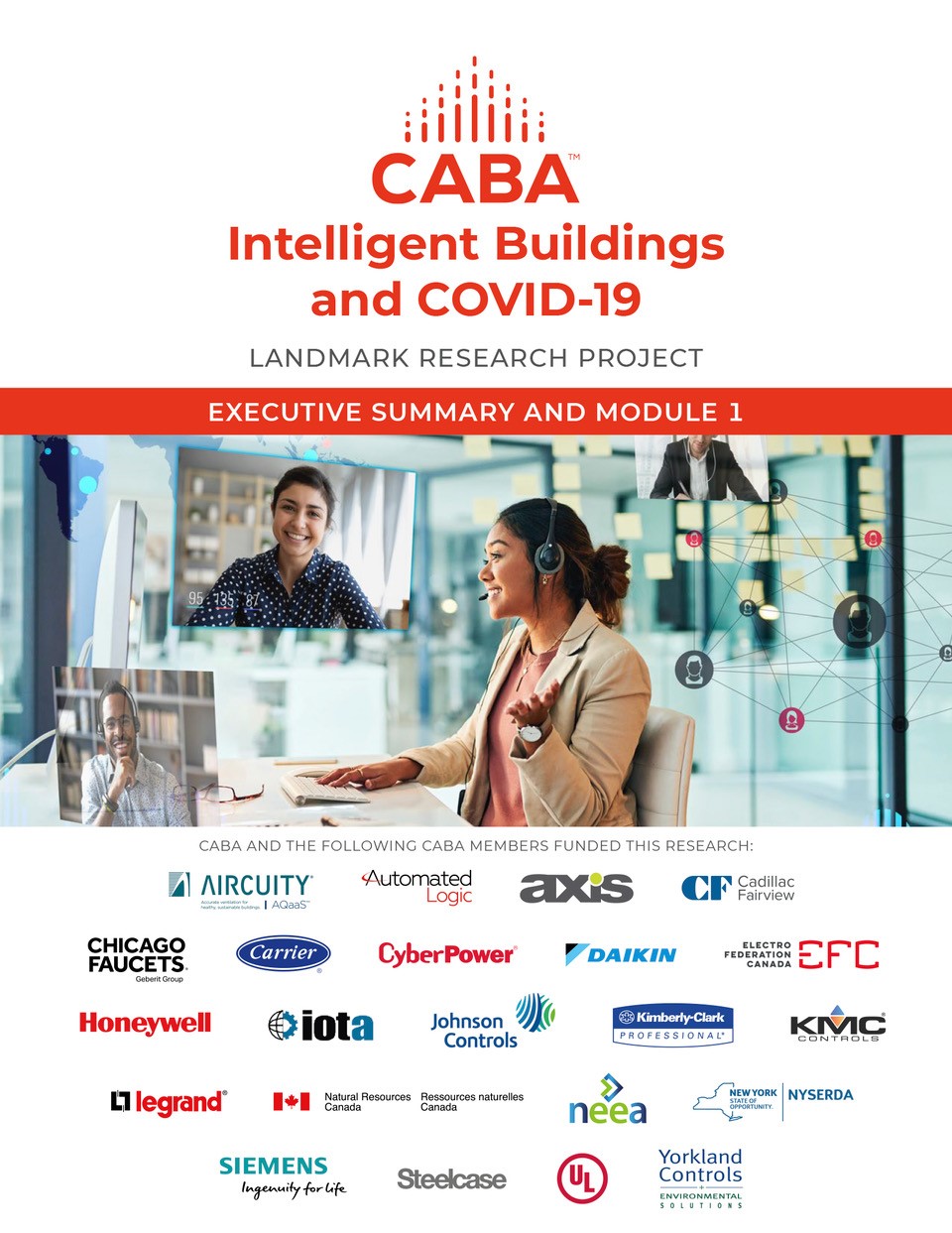by Brianna Crandall — May 7, 2021 — The Continental Automated Buildings Association (CABA), an international not-for-profit industry association dedicated to the advancement of connected home and intelligent building technologies, has just completed the Landmark Research Project Intelligent Buildings and Covid-19.
CABA commissioned Frost & Sullivan, a CABA member, to evaluate the key issues and challenges presented by Covid-19 for the intelligent buildings industry. This research examined the pandemic’s immediate and longer-term impact; the implications for technology evolution to meet post-lockdown requirements; and the measures that will help build future resiliency for this industry.

The report evaluates the key issues and challenges presented by Covid-19 for the intelligent buildings industry. Image courtesy CABA
Ron Zimmer, CABA president and CEO, stated:
The findings of this research validate the approaches of several of the more forward-thinking OEMs, distributors, and technology providers who adopted a longer-term view of this pandemic and understood the need to re-strategize their products and service offerings. The research also sets out key takeaways for the end-users tasked with determining the solutions that will make their indoor environments healthy and safe in future — the building owners and operators, facility managers and buildings occupants.
Konkana Khaund, director of Consulting, Energy and Environment with Frost & Sullivan, remarked:
The goal of this project was to evaluate the key challenges and opportunities and identify response measures that will help build resiliency. As intelligent-buildings industry participants deal with the economic slowdown and fundamental shifts brought about by COVID-19, there are distinct pockets of opportunity that the emerging future scenario could deliver.
The report highlights the ways in which artificial intelligence (AI)-based building solutions; heating, ventilation and air-conditioning (HVAC) optimization; cloud-based remote services and other key post-Covid-19 applications have gained profile. When combined with resilient business models, these technologies are expected to help industry players gain a competitive edge in the post-Covid-19 environment.
As control measures against Covid-19, touchless elevator controls, sensors, ultraviolet (UV) lighting, thermal imaging, indoor air quality (IAQ)-based ventilation and pathogen scanners are also attracting significant interest. Stakeholders are also turning increasingly to cloud-based remote services, HVAC optimization and building-health performance benchmarking to ensure safe operation of systems that were shut down during the lockdown, according to the report.
Companies that offer cloud-based services, predictive maintenance, HVAC optimization, workplace analytics, and washroom solutions will play a major role in defining the workplaces of the future, the research underlines. Market participants can expect to see accelerated deployments in many of these areas over the next three years.
In addition to innovative technology solutions, industry players are relying significantly on business model transformation to prepare themselves for a post-COVID world. “As-a-service” offerings to achieve objectives related to digital transformation, pandemic response capability, improved air quality control, and healthy-buildings benchmarking will resonate with customers in the post-pandemic environment, as well as assist companies to devise competitive go-to-market strategies, notes the report.
Khaund added:
A great example of this trend is air-quality-as-a-service, or AQaaS. While a few customers were exploring this option before the pandemic, interest in this model has gained momentum in the past six months, largely driven by commercial real estate and higher education institutions looking for ways to reassure their constituents that they can return safely, while doing so as economically as possible.
Finally, the research identified and evaluated essential new design and planning considerations for intelligent buildings. This analysis was supported by a review of how existing buildings were repurposed to support alternate infrastructure requirements during the pandemic. Among the key lessons from this part of the report:
- Strong use cases for future intelligent buildings involving IAQ-based ventilation, health and well-being and emergency response applications, technology-based social distancing and contact tracing applications are being developed by start-ups and leading companies in this space.
- Intelligent buildings-based proptech innovations in spatial intelligence, health and well-being, and remote services involving core technologies such as Internet of Things (IoT) sensor networks, artificial intelligence (AI) and cloud services are anticipated to play a crucial role in shaping the intelligent building of the future.
The report provides assessments about the likely rollout and evolution of various solutions. For example, with regards to spatial intelligence innovations, the Report predicts that occupancy detection-based social distancing, indoor positioning-based contact tracing, and AI-based lighting control will be at an “implementation” phase from 2023 onwards, while workplace analytics will have reached an “established” phase from mid-2024. Altogether, nearly $35 billion has been invested in intelligent buildings-based proptech innovations including the third quarter of 2020.
The following CABA members funded the project: Aircuity, Inc.; Automated Logic Corporation; Axis Lighting, Inc.; The Cadillac Fairview Corporation Limited; Carrier Corporation; Chicago Faucets/Geberit Group; Cyber Power Systems (USA) Inc.; Daikin Applied Americas Inc.; Electro-Federation Canada; Honeywell International, Inc.; Iota Communications, Inc., Johnson Controls, Inc., Kimberly-Clark Professional, KMC Controls, Inc., Legrand, National Research Council (NRC), Northwest Energy Efficiency Alliance (NEEA), NYSERDA, Siemens Industry, Inc., Steelcase Inc., UL LLC, and Yorkland Controls Ltd.
A 40-page Report that includes both the Executive Summary and Module 1 is now freely available in the CABA Store, while the complete, 100-page Report that also includes Modules 2 and 3 was recently shared with the funders. (That Report will be available for sale in the CABA Store following a brief embargo period.)





